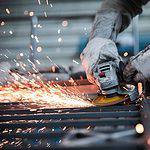Today we will discuss about electromagnetic clutch. In my previous posts we have discussed about types of clutch. We know that according to the engaging effect, clutch has two types. The first one is positive displacement clutch and the other one is friction clutch. Every clutch requires a holding force which takes care of proper engaging and disengaging clutch. This force is sometimes obtained by spring stored energy and sometimes by other source of energy. An electromagnetic clutch is also a friction clutch which uses electromagnetic force to engage and disengage the clutch.
After reading this paragraph, some questions arises in our mind.
1. What is electromagnetic force?
2. How a clutch uses this force to engage and disengage clutch?
3. How a practical electromagnetic clutch works?
You can find answer of those questions in this article.
What is Electromagnetic force?
It is a fundamental force associated with electric and magnetic field. In simple words, two particles attracted towards each other due to electric charge or magnetism is called electromagnetic force. It is a stronger than gravity but weaker than nuclear force. This force comes into action when two electric charges or magnetic particles comes into contact. Any magnet attracts iron pieces towards it due to electromagnetic force.
Electromagnetic Clutch:
Principle:
Before discussing about electromagnetic clutch first you should know about basic fundamentals of clutch. Clutch is a device which engage or disengage two shafts called driving shaft or engine shaft and driven shaft or gear box shaft. A simple basic clutch consist two pressure plates, one is connected with engine shaft and other one with gearbox. The pressure force is applied by the spring arrangement which forced these plates towards each other when the clutch pedal is not pressed. There is a friction plate between both of these pressure plates. When the engine shaft rotates, it makes rotate the gear shaft due to friction force between them. When the driver press the clutch pedal, both pressure plate loose contact with each other and clutch is in disengage position. This is basic of any clutch. All friction clutches work on same principle. An electromagnetic clutch is also a friction clutch but it uses magnetic force in place of spring force to engage and disengage the clutch. It also consist two clutch plates (Rotor and Hub). One of them is connected with the electric circuit. When the electricity passes through this plate, it converts it into electromagnet which attract the other plate towards it. There is also a friction plate between them. The magnetic field apply force to connect both these plates and friction plate transmit torque between them. Thus this clutch is combination of both electromagnetic effect and mechanical clutch. Now we will discuss construction and working of this clutch.
Construction:
This clutch consists following parts.
Rotor:
Rotor is a major part of this clutch witch is connected directly to the driving shaft or engine shaft. It continuously rotate along with the driving shaft.
Winding or Coil:
Winding coil is situated behind the rotor and remains in stationary position during clutch working. It is shown in figure. A high voltage DC supply is connected with this winding which transfer a high voltage current into this winding and convert it into electromagnet.
Armature:
Armature is situated at front of the rotor. It is connected to the hub or pressure plated with the help or rivet or bolted joint.
Hub:
Hub or pressure plate is bolted with the gear shaft or driven shaft and rotates with it. It is situated after the armature.
Friction Plate:
Friction plate is inserted between armature and rotor according to the requirement.
Supply unit:
Supply unit consist clutch switch, battery, wire etc.
Working:
The electromagnetic clutch working can be summarized into following points.
- In the initial condition the clutch is in disengage position. There is an air gap between rotor and hub.
- First the engine starts which makes rotate the rotor connected with the engine shaft.
- A DC battery supplies DC current into the clutch winding.
- This high voltage DC current converts this winding into an electromagnet which attract armature towards it.
- This armature force friction plate towards the rotor and make rotate the hub.
- Thus the hub rotate and the rotor transmit 100 percent torque during engage position.
- When the clutch switch / pedal is pressed, the battery stops the supply in winding which remove the electromagnetic force, thus the clutch is in disengage position.
Advantages:
- No linkage is required to operate the clutch. So it can be installed any remote location.
- It can be used to achieve automatic transmission.
- Easy to operate.
- Less wear and tear at contact point.
Disadvantages:
- This clutch operating temperature is limited by the temperature rating of the insulating material.
- High initial Cost.
This is all about electromagnetic clutch principle, working advantages and disadvantages along with its diagram. If you have any query regarding this article, ask by commenting. If you like this article, don’t forget to share it on social networks. Subscribe our website for more informative articles. Thanks for reading it.






Can u tell me the comparison of this clutch with other clutches